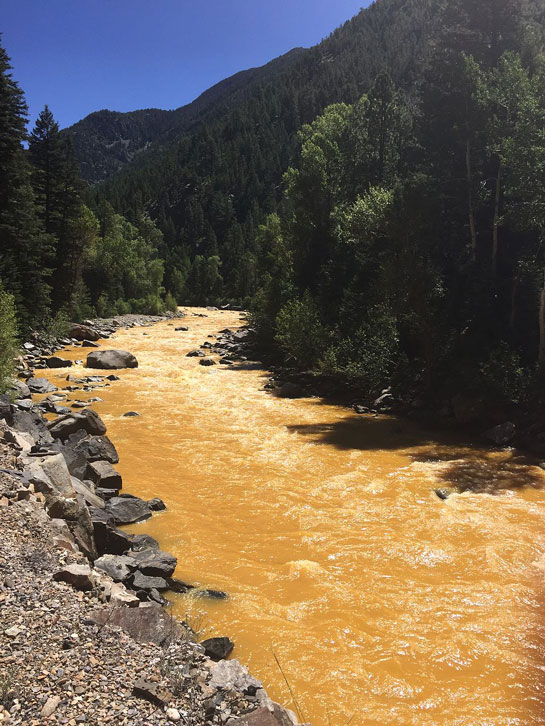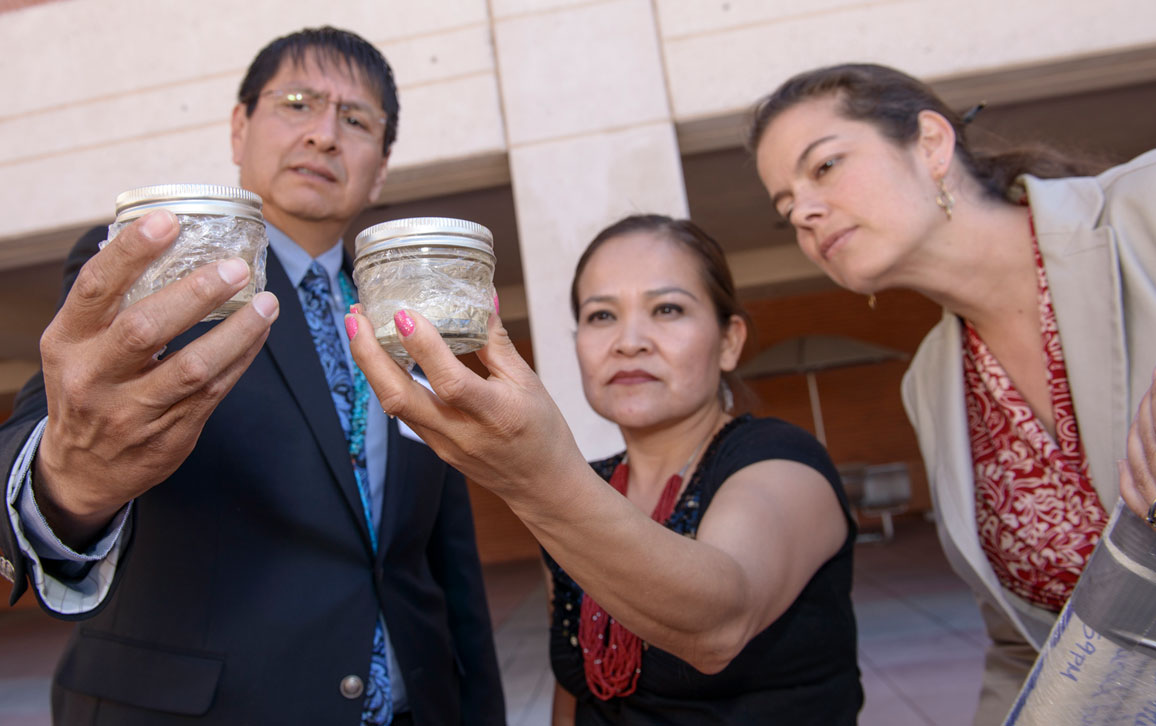Navajo-Led Science in Pursuit of Environmental Justice
By Gabriela Serrato Marks
Hydrologist Karletta Chief and her team demonstrate the importance of community-led science in the aftermath of the Gold King Mine spill.
January 21, 2020
Macroscope Environment Ethics Human Ecology
On a summer day in 2015 in Silverton, Colorado, just a few miles from the border with New Mexico, 3 million gallons (11.4 million liters) of acidic water and mine waste flooded into Cement Creek and the Animas River. This disaster wasn’t a natural one: The U.S. Environmental Protection Agency (US EPA) had been assessing the mine waste for possible treatment and drainage, but instead, they accidentally caused the spill. Over the next few days, weeks, and months, the Gold King Mine spill affected crops, livestock, and access to water in three states and two Native American reservations.
One of the scientists researching the effects of the August 5, 2015 spill is Karletta Chief, an associate professor in environmental sciences at the University of Arizona. She is also Diné, or Navajo, and grew up on the Navajo Nation, which faced multiple adverse effects because of the mine waste spill. She’s been working to ensure that her community has access to all the data they need on environmental exposures to heavy metals, while also setting an example for other scientists who want to work with indigenous groups.

Wikimedia Commons
In the days after the spill, many farmers and community members were anxiously waiting to hear whether the river water was safe to use or drink. However, even after both the US EPA and the Navajo Nation EPA tested the water for heavy metals and deemed it safe, people remained concerned that the water was not truly clean. Part of this mistrust is rooted in historical trauma, explains Chief. “Colonial science, where scientists come in, gather data without permission or hire someone to collect the samples to mail to their labs, has happened in the past,” Chief told me in an interview at the Society for the Advancement of Chicanos and Native Americans in STEM annual meeting. Chief continued, “There’s history of data being collected and not being returned, or data not being disseminated. It infringes on data sovereignty, and there’s no transparency in the whole process. [Some Diné people] don’t trust Western scientists.”
Since 2016, Chief has been part of a team, which includes community health representatives from the Navajo Nation, that is investigating exposures and risk perceptions after the Gold King Mine spill. They’re trying to better understand the health effects of the spill and how people decided whether the water was safe to drink, and are implementing a sampling protocol that any local can help with. There’s even a series of videos about the research project narrated in Diné, so that any Navajo elders who are not as comfortable listening to English can fully understand the project.

Courtesy of Paloma Beamer
Chief’s approach is different from that of other researchers because she has developed a two-way relationship with Navajo communities, and scientists are not in charge. “The community is leading the process to address their own environmental catastrophe,” Chief said. The community’s stance on mining hasn’t changed since the spill, but what has changed is that “their perspectives have been included in the science.” In Chief’s research, Diné people have been driving the research questions, voicing their concerns through each phase of the project, and helping to identify solutions. More than four years after the spill, there are still questions to answer.
Of course, Chief isn’t the only researcher engaging with indigenous communities. Environmental researchers have long noted that indigenous knowledge can be a rich form of scientific data; for example, it might include oral histories as empirical observations of the natural world. That model is ideal for scientific communities—after all, what scientist doesn’t want more data? But that approach is extractive and doesn’t create a collaborative environment conducive to building a relationship. To better work with indigenous communities, Chief explains, Western-trained scientists should make sure that they take a step back and listen, instead of coming in with a plan they want to implement. Indigenous knowledge systems can act as an ethical framework for better science, even if it’s different from how we typically conduct our research projects.
Chief’s work helps to show how natural scientists can develop and maintain a more equitable relationship with indigenous communities, so that everyone can benefit. Using indigenous traditional ecological knowledge alongside Western-origin science can build trust between professional researchers and indigenous scholars. The U.S. National Park Service page on traditional ecological knowledge points out that “a critical aspect of conservation biology and associated caring for the environment is acquiring information that is not only accurate, but trusted by those who make and abide by the decisions based on that information. The use of traditional ecological knowledge offers one way of bridging gaps in perspective and understanding.”
This approach isn’t just about ethical behavior, though: These relationships built on respect can result in better environmental outcomes. In Nicaragua and Honduras, for example, collaborations between the indigenous Mayangna and Miskito peoples and conservation biologists, led primarily by the indigenous groups, have successfully documented traditional knowledge about aquatic lake fauna for the scientific community while also ensuring that the people could use their sovereignty to halt deforestation and expanding agriculture. These efforts seem to be more effective than an externally driven management plan.
Since the Gold King Mine spill in 2015, the US EPA has spent $29 million to clean up the Animas River, and the area is now designated as a Superfund site. Perhaps as Chief’s project wraps up, conditions and community relationships will start to improve.
“We’re at a point where Native voices are being elevated across the world, from the Amazon to the Black Hills to Gold King Mine spill,” Chief said. “It shows this passion and commitment of indigenous people to protect Mother Earth and Father Sky. That’s not something that’s new—it’s really a deep, embedded belief in our prayers and ceremonies. I hope the world will listen and take action.”
American Scientist Comments and Discussion
To discuss our articles or comment on them, please share them and tag American Scientist on social media platforms. Here are links to our profiles on Twitter, Facebook, and LinkedIn.
If we re-share your post, we will moderate comments/discussion following our comments policy.